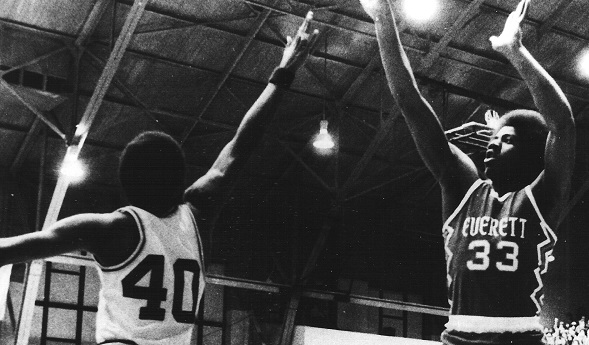
BCAM Names '7s' Retro Mr Basketball Winners
May 1, 2017
Basketball Coaches Association of Michigan
Forty years after scoring his last basket at the high school level, Earvin “Magic” Johnson is finally a BCAM Mr. Basketball.
“When we began talking about this award, we thought of all the great players who never had the opportunity to win it,” said Al Schaffer, chairman of the Association’s Mr. Basketball committee at the announcement of the Michigan’s Mr. Basketball award back in 1981. “Players like Earvin Johnson, Dave DeBusschere, Chet Walker, Frank Tanana, Sr.; Mel Peterson, Richie Jordan, Campy Russell and many, many others.”
In 2010, the Basketball Coaches Association of Michigan launched a decade-long program meant to honor those very athletes. The Retro Mr. Basketball award looks back at the state’s top senior prep basketball players for the years 1920 through 1980. This year marks the eighth year of the project, and places the spotlight on the senior athletes for the years that end in seven – 1927, 1937, 1947, 1957, 1967 and 1977.
“Those six school years include some of the state’s greatest names,” said BCAM president Tom Hursey. “BCAM was incorporated in the summer of 1976, and first presented the ‘Mr. Basketball’ award in 1981 to Lansing Eastern’s Sam Vincent. Earvin ‘Magic’ Johnson was one of the inspirations for the award. It’s nice to see him honored after all these years.”
Members of the Association’s Retro Mr. Basketball committee assembled between sessions of the MHSAA Boys Basketball championships in March to identify, then select the latest group of honorees.
“With their selections, a total of 49 seniors from the Retro years have now been named,” said Ron Pesch, historian for the Michigan High School Athletic Association and the individual tasked with identifying candidates for the award. “When combined with the 37 winners of the modern Mr. Basketball award, Michigan now has 86 individuals we call “Mr. Basketball.”
The names of this year’s selections will be added to plaques that surround the base of the original Mr. Basketball trophy created by BCAM in 1981.
PAST WINNERS OF BCAM’S RETRO MR. BASKETBALL AWARD
(College Attended Shown In Parenthesis)
1980 Tim McCormick, Clarkston (Michigan)
1976 Stuart House, Detroit Denby (Washington State)
1975 Bruce Flowers, Berkley (Notre Dame)
1974 Tony Smith, Saginaw (Nevada-Las Vegas)
1973 Tom LaGarde, Detroit Catholic Central (North Carolina)
1972 Larry Fogle, Detroit Cooley (Canisius)
1971 Michael "Campy" Russell, Pontiac Central (Michigan)
1970 Rick Drewitz, Garden City West (Kentucky)
1966 Rudy Tomjanovich, Hamtramck (Michigan)
1965 L.C. Bowen, Benton Harbor (Bradley)
1964 Willie Betts, River Rouge (Bradley)
1963 Craig Dill, Saginaw Arthur Hill (Michigan)
1962 Ernie Thompson, Saginaw (Bradley)
1961 Reggie Harding, Detroit Eastern
1960 Peter Gent, Bangor (Michigan State)
1956 Mel Peterson, Stephenson (Wheaton)
1955 M.C. Burton, Jr., Muskegon Heights (Michigan)
1954 Pete Tillotson, Ludington (Michigan)
1953 Ron Kramer, East Detroit (Michigan)
1952 Frank Tanana, Sr., Detroit St. Andrew
1951 Webster Kirksey, Saginaw (Eastern Michigan)
1950 Charlie Primas, Detroit Miller (Wayne State)
1946 Jack Forestieri, Benton Harbor (Norte Dame)
1945 Bob Swanson, Lansing Sexton (Michigan)
1944 Dick Rifenburg, Saginaw Arthur Hill (Michigan)
1943 Don Boven, Kalamazoo Central (Western Michigan)
1942 Larry Savage, Saginaw (Northwestern)
1941 Don Osterman, Detroit St. Theresa (Villanova)
1940 Ralph Gibert, Flint Northern (Michigan)
1936 Charles Pink, Detroit Northwestern (Michigan)
1935 John Zwier, Holland Christian
1934 Earl Brown, Jr., Benton Harbor (Notre Dame)
1933 Lincoln Dodson Truss, Flint Northern
1932 Lowell Matteson, Portage
1931 Edward Huttenga, Grand Haven (Western Michigan)
1930 John Tooker, Kalamazoo St. Augustine (Michigan)
1926 Roger Grove, Sturgis (Michigan State)
1925 Joe Truskowski, Detroit Northeastern (Michigan)
1924 Bennie Oosterbaan, Muskegon (Michigan)
1923 Henry Schrumpf, Niles (Western Michigan)
1922 Royal Cherry, Grand Rapids Union (Michigan)
1921 George Haggarty, Ypsilanti (Michigan)
1920 Harry Kipke, Lansing Central (Michigan)
2017 SELECTIONS FOR BCAM’S RETRO MR. BASKETBALL AWARD
(The winner of the award is listed below at the top of the page in ALL CAPS, while finalists for the award follow and are listed alphabetically.)
1977 RETRO MR. BASKETBALL
EARVIN ‘MAGIC’ JOHNSON, LANSING EVERETT – “May be the best prep player ever in Michigan” stated United Press International at the conclusion of his prep career, and today, few would debate that assessment. Johnson totaled 2,012 points in his high school career, including an average of 28.8 points per game as a senior. Dominant across all aspects of the game, opposing coaches praised his ability to control a contest. The sophomore fouled out in his varsity debut, missing about a third of the game, but still grabbed 16 rebounds and scored 12 points against Holt in early December 1974. By February of 1975, Lansing sportswriters called him “Magic.” A first-team Parade All-American as a 6-foot-8½, 198 pound senior, Johnson was named a first-team all-stater by The Associated Press in all three years of varsity play. In 1977, Johnson led Everett to a 62-56 overtime victory over Birmingham Brother Rice in one of the all-time classic Class A title games.
1977 FINALISTS
Rick Baillergeon, Maple City Glen Lake, 6-2 – Scored 16 points as Glen Lake downed Detroit East Catholic 70-68 for Class D championship. The points brought Baillergeon’s four-year career total to 2,144 – second most in the state at the time behind Richie Jordan, who tallied 2,210 points for Fennville between 1962 and 1965, and four more than Dom Jacobetti’s total of 2,140 points, scored over four seasons at Negaunee St. Paul. A 60-percent field goal shooter, Baillergeon continued his playing days at Ferris State.
Tim Bracey, Grand Rapids Creston, 6-2, 170 – Excellent at both ends of the court, Bracey was a two-time scoring champion in the City League and averaged 24.3 points, 13 rebounds, and six assists per game as a senior.
Kevin Smith, Birmingham Brother Rice, 6-1½, 165 – Called “the finest guard to ever play basketball in the Catholic League” by Mick McCabe of the Detroit Free Press, Smith was accurate on 81 percent of his free throws while averaging 29 points, seven assists, five steals and six rebounds per contest as a senior. His 47-foot shot at the end of regulation of the 1977 Class A championship against Lansing Everett sent the contest to overtime.
Jay Vincent, Lansing Eastern, 6-7, 230 – Vincent was a starter beginning his sophomore year but played largely in the shadow of Earvin Johnson. Still, he was the second-leading vote getter on the UPI all-state team. Vincent totaled 1,512 points over his prep career, a number that would have been higher had Eastern been able to get past Johnson and Everett in the District round of the annual MHSAA tournament during those three seasons.
1967 RETRO MR. BASKETBALL
SPENCER HAYWOOD, DETROIT PERSHING – “He just might be the finest 16-year-old player in the United States,” said his coach Will Robinson about the transfer from Mississippi who arrived at Pershing in the fall of the 1965-66 school year. Only the Detroit Free Press named the 6-foot-7 junior to its all-state team that winter, but one year later, the Detroit News, Free Press, Associated Press and United Press International had all discovered Haywood, and named him to their respective top all-state squads. Haywood demanded respect around the boards, grabbing 544 rebounds – 169 on offense and 375 on defense – while blocking 160 shots. A Parade magazine third-team All-American, he averaged 29.1 points per game as a junior and 25.6 over his prep career, hitting on 74 percent of his free throws while dishing out 120 assists. Helped lead the Doughboys to the 1967 Class A championship, the first for Robinson.
1967 FINALISTS
Tim Bograkos, Flint Central, 6-1, 175 – The second player in Flint history to score more than 600 points in his career, Bograkos totaled 726 points over two seasons of varsity play. Honor student and team captain of the football, basketball and baseball teams, as a senior he averaged 17 points per game, leading the Indians to the Class A Final, a 90-66 loss to Detroit Pershing.
Dan Fife, Clarkston, 6-3½, 185 – Averaged 12 rebounds and better than 32 points per contest as a senior. Scored 52 points in a game and totaled 1,589 points over his three years of varsity play at Clarkston. Fife played college ball at Michigan, then returned to Clarkston where he has served as varsity basketball coach for 35 years. In March 2017, the Wolves topped Grand Rapids Christian for the Class A championship – a first for Coach Fife.
Ralph Houston, Muskegon Heights, 6-4½, 178 – Possessing excellent size and speed, Houston averaged just shy of 20 points per game for the Tigers, scoring 381 points total while corralling 208 rebounds as a senior.
Kennedy McIntosh, South Haven, 6-6½, 220 – A Class B all-state selection as a junior, McIntosh earned Dream Team recognition from the Detroit News as a senior, averaging 18 rebounds and more than 25 points per game during his graduation year. Attended Eastern Michigan following high school before advancing to the NBA.
1957 RETRO MR. BASKETBALL
ED BURTON, MUSKEGON HEIGHTS – A rugged rebounder who carried a 20-point-plus scoring average as both a forward and center, the 6-foot-6, 201-pound Burton was the top vote getter in the Detroit Free Press coaches all-state poll. Scored 1,143 points to break the Heights’ career scoring mark set by his brother, M.C. Burton, by two points. As a senior, “Big Ed” hit 20 field goals and tallied 44 points versus Traverse City in tournament Quarterfinal play, and 17 points versus Benton Harbor and star junior Chet Walker in the Semifinals. In the 1957 Class A title contest, Burton scored 25 points, including 13 of 15 shooting from the foul line, against Detroit Austin Catholic and its top ballplayer, junior Dave DeBusschere. Burton’s 31 rebounds against Traverse City in Quarterfinal action still stands as an MHSAA final round record.
1957 FINALISTS
Charles North – Detroit Northwestern, 6-3½, 185 – Led Northwestern to the City Championship, and was the team’s top rebounder and clutch scorer. Later played for the University of Detroit.
Dave Southwell – Parma Western – 6-4, 205 – A repeat first-team all-state selection by the Free Press, Southwell was amazingly agile, and turned in his best games against Parma’s toughest opponents. “Would rather set up his teammates than to score himself,” wrote the Michigan Center coach at the time of balloting for the 1957 all-state team. “He took eight shots against us and hit on five.” High praise considering Southwell put up 47 against Michigan Center as a junior.
Tom Villemure, Newberry, 5-10, 180 – Averaged 33.3 ppg as a guard at Newberry, and was the state’s leading scorer in 1957. Later a two-time MVP at Sault Tech (now Lake Superior State) then continued his playing career at University of Detroit. Served as head coach at Grand Valley State for 24 years.
Tom Wilson, Lapeer, 6-1, 178 – The top name in Class B basketball in 1957. Scored over 1,300 points in his career at Lapeer and 36 points or more in six straight games. Tom was the third of the Wilsons to play football at Michigan State behind oldest brother John, a defensive back at MSU, and Pat, a quarterback and basketball player for the Spartans. Tom would also play both sports at Michigan State.
1947 RETRO MR. BASKETBALL
SAMMY GEE, DETROIT MILLER – A 5-foot-8, 150-pound set-up artist, Gee was a quick thinking floor general and one of the city’s top scorers for coach Will Robinson’s Trojans. Well known across the state despite the fact Detroit Public School League teams did not compete in the MHSAA-sponsored tournament, Gee scored 15 points to lead all scorers as Miller won its first-ever PSL championship before 8,000 fans at the State Fairground Coliseum in Detroit. Miller then downed Detroit St. Joseph in Detroit’s first postseason championship between the PSL and the city’s parochial champion. The game was played in front of 16,041 spectators at Olympia Stadium, at the time the largest crowd ever to see a basketball game in Michigan. As a testament to his skills, Gee was signed by the Harlem Globetrotters out of high school. An outstanding baseball player as well, he was inked by the Brooklyn Dodgers and played minor league ball for the organization for parts of two seasons.
1947 FINALISTS
Bill Agre, Saginaw Arthur Hill, 6-0, 150 – Only Saginaw Valley member to score a spot on the Detroit Free Press all-state first team. An aggressive, hard driving guard, Agre was the Valley’s top defensive player and received the most votes when named to the league’s all-conference team.
Chuck Murray, Birmingham, 5-11 – Another first-team selection by the Times, Murray also was named to the second team by the Free Press. Considered one of the state’s most versatile athletes, competing in football, baseball and track, but basketball was considered his best sport. Held Birmingham’s single-season scoring mark with 210 points in 15 games.
Bob Nagel, Lansing Eastern, 6-2, 185 – A unanimous all-5A Conference first-team selection, Nagel was a first-team selection in the Free Press. An outstanding all-around athlete, he was Class A pole vault champion in the spring of 1947.
Bob VanDyke, Holland – 6-5, 200 – Scored 296 points in 17 games to set a new scoring record at Holland, with six games of 20 points or more.
1937 RETRO MR. BASKETBALL
BOB OSTERMAN, DETROIT ST. THERESA – A 6-foot-4 center, Osterman led Detroit St. Theresa to Class B titles in 1936 and 1937. Only first team repeater on the Detroit Free Press all-state squad, he was named to the paper’s second team in 1935 as a sophomore. Scored 793 points over four years at St. Theresa – better than 11 points per game. Tallied 16 points in a little more than three quarters of play, as St. Theresa downed Marshall in the Class B Final in 1937. Later played football at Notre Dame. Brother of Don, who was named Retro Mr. Basketball for the 1940-41 season.
1937 FINALISTS
Gene Brogan – Lansing St. Mary – A clever dribbler and top-notch playmaker, Brogan was the main cog in St. Mary’s drive to back-to-back Class C championships. Helped the “Big Blue” piece together a 27-game win streak spanning the 1936 and 1937 seasons. The loss, to eventual 1937 Class B champion Detroit St. Theresa, was St. Mary’s lone defeat in 25 matchups in ’37 and one of four over the two-year span.
Jack Newman, Grand Rapids Union – “A fine passer,” Newman was the “leading scorer in the Grand Rapids City League for two seasons.”
Melvin Peterson, Muskegon – Captain and top marksman for the Big Reds, Peterson helped guide Muskegon to a flawless 18-0 mark and the Class A championship. A guard praised for his playmaking ability, he finished third in scoring in the Southwestern Conference with 64 points over 10 games. Later played basketball at Michigan State.
Grady Truss, Flint Northern – The first African-American player to captain Northern’s basketball team, the 6-foot-4 Truss played center and finished his senior year as the second-leading scorer in the Saginaw Valley league with 108 points. A first team all-state selection by the Free Press, Truss earned second team all-state honors as a junior, and was a third team pick as a sophomore. Northern finished as runner-up to the state title in 1935, won the Class A title in 1936, and advanced to the Quarterfinals, losing to cross-town rival Flint Central, in 1937. Grady was the younger brother of Lincoln Dodson Truss, who was named Retro Mr. Basketball for the 1932-33 season.
1927 RETRO MR. BASKETBALL
BILL MCCALL, MUSKEGON – Led the basketball team to a 20-1 record and a Class A championship in the winter of 1927. Named to the All-Tournament team, McCall was also a two-time all-state selection in football, where he helped guide Muskegon to mythical championships in the falls of both 1926 and 1927, the first titles under the leadership of head coach C. Leo Redmond. Later starred at Dartmouth University in both sports.
1927 FINALISTS
Harold Green, Detroit Northern – Named captain of the Detroit Free Press mythical All-City team, Green was “a small thin chap,” who played “like a flash of lightning.” Finished second in scoring in Detroit as a senior, he was considered one of the few players who could do all things well.
George Markley, Pontiac – In his first year on varsity, Markley developed into a brilliant player. His specialty was tapping the ball in from under the basket and his work in the MHSAA tournament, played at Detroit Central, earned him the position of All-Tournament forward.
Al Milanski, Detroit Northeastern – Twice named to the first-team All-City squad by the Detroit Free Press. Top scorer in the city, Milanski averaged better than 10 points per game as a senior. “Fast man down the floor, especially adept at receiving passes and one of the surest shots in the city within a reasonable distance of the basket.”
Ray Priest, Battle Creek Central – Outstanding forward of the state tournament, according to the Battle Creek Enquirer. Played a beautiful floor game, offensively and defensively. First player in Battle Creek history to earn all-state in both football and basketball. Mid-year grad. Played football at the University of Michigan following high school.
PHOTO: Lansing Everett's Earvin Johnson (right) puts up a shot over Lansing Eastern's Jay Vincent during their high school careers.
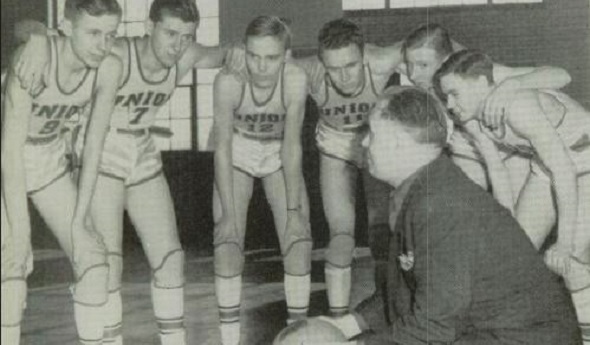
The Last Time MHSAA Finals were Canceled
By
Ron Pesch
MHSAA historian
April 27, 2020
Historians trace the start of World War II to German dictator Adolph Hitler’s decision to invade Poland on September 1, 1939. The Empire of Japan’s involvement in the war became effective in September 1940 with the signing of the Tripartite Pact.
Until December 7, 1941, the United States avoided official involvement, declaring themselves “a neutral nation.” Then came Imperial Japan’s bombing of Pearl Harbor.
A labor shortage caused by World War I had taken out spring high school sports in Michigan in 1917. As noted in the Second Half article, “1918 Pandemic, WWI Threatened High School Sports,” the global spread of a devastating strain of influenza interrupted the football season in Michigan. Prep athletics would roar through the 1920s and survive the Great Depression before seeing another interruption.
That next disturbance had nothing to do with war’s insatiable desire for manpower. Rather, it was because of tires.
“When the Japanese bombed Pearl Harbor, rubber instantly became the most critical strategic material for making war,” wrote Stephen W. Sears in the October/November issue of American Heritage magazine in 1979. “Nine-tenths of the nation’s rubber came from the Far East, and it was painfully evident that nothing would now stop Japan from cutting off that source.”
Americans consumed nearly two-thirds of the world’s production of rubber. With only about a year’s worth of material on hand, “Just four days after Pearl Harbor a freeze was put on the sale of new passenger-car tires,” stated Sears, “and on December 27 tire rationing was authorized, to go into effect early in January, 1942. Sales of new cars also were halted.”
The MHSAA
The Michigan High School Athletic Association arrived in December 1924. It replaced the old Michigan Interscholastic Athletic Association which had served Michigan for 15 years.
The organization’s primary purpose was to standardize, interpret and administer rules, educate and guide officials, and regulate student eligibility within prep sports in Michigan. By the 1940s, it had evolved into an association that also managed postseason tournaments, designed to identify state champions in specific sports: swimming, cross country, golf, tennis, track, and the sport sponsored by the most high schools in the state, basketball.
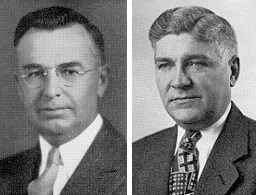 “The old MIAA had taken over the regulation of basketball tournaments in 1920. This had been done as a service to the schools and especially as a means of eliminating evils inherent in the invitational tournaments (that were hosted by various colleges around the state and the midwest),” wrote Lewis L. Forsythe in his book, Athletics in Michigan High Schools, recalling the first 100 years of prep sports in the state.
“The old MIAA had taken over the regulation of basketball tournaments in 1920. This had been done as a service to the schools and especially as a means of eliminating evils inherent in the invitational tournaments (that were hosted by various colleges around the state and the midwest),” wrote Lewis L. Forsythe in his book, Athletics in Michigan High Schools, recalling the first 100 years of prep sports in the state.
“In the last days of February 1942,” multiple Michigan schoolmen were in San Francisco to attend the annual meetings of Secondary School Principals, Superintendents and the National Federation of State High School Associations. “We were well aware that many of our boys in school would have to offer themselves in the service of their country,” noted Forsythe in his publication. “We fully realized that the quality of that service and, indeed, their own survival might well depend quite as much on their physical fitness as on their intellectual and spiritual resources. It was under those circumstances that we determined so to modify the emphasis of our athletic program as to make the largest possible contribution to the war effort. We recognized that the need in Michigan could not be met by our organization alone, and we therefore determined to encourage a general enrollment of all school groups in a united effort for promotion of physical fitness.”
Because of the “scarcity of tires and automobiles,” in April 1942 the MHSAA announced plans to curtail their upcoming annual golf and tennis events, eliminating a state championship round. Instead, the seasons were concluded with separate eastern and western sectional tournaments, hosted in Ann Arbor and Grand Rapids.
Early in May of 1942, MHSAA executive director Charlie Forsythe, nephew of Louis Forsythe, announced that the Association was “working on plans designed to make body-building exercises available to more young men and to spread recognition of sports achievements. He predicted substantial growth of intramural sports to include youngsters whose limited prowess might keep them from such interscholastic sports as football, baseball or basketball.”
Wire articles had told the story of how the running Battle of the Atlantic had impacted U.S. ocean transportation along the eastern seaboard. A Germany-mounted “campaign against American coastal shipping” by U-boats (submarines) was devastating “a section of America almost exclusively dependent upon ocean-point tankers for its petroleum products.” Without a viable alternative means to transport the products, on May 15, 1942, gasoline rationing began in 17 seaside states and the District of Columbia. It was hinted that gas rationing – specifically designed to save rubber – could roll out nationally. (Crude oil is the main ingredient in man-made rubber.)
The chances for restrictions in Michigan were a distinct possibility. According to P.J. Hoffmaster, the state’s supervisor of wells, the state consumed approximately 140,000 barrels of oil per day, but produced only 64,054 barrels. “This state has a shortage of at least 100,000 barrels on the basis of a regional demand,” he said, noting Michigan oil also supported needs outside the state. “When people say there can’t be rationing in Michigan because we have plenty of our own oil, they don’t have the true picture.”
Reverberations begin
When quizzed on the subject before the annual Lower Peninsula Track and Field championships, hosted at Michigan State College in May 1942, (Charlie) Forsythe, told The Associated Press he was unsure how rationing might affect the Association’s annual playoffs.
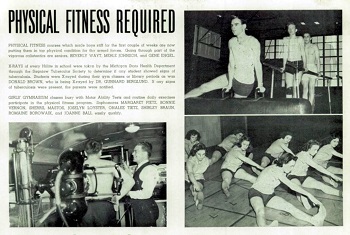 “It is too early as yet to say exactly. … We are making every effort to maintain an adequate athletic program. Certainly where common carriers (busses and trains) will make it possible to get a team to a game, that means should be used,” Forsythe said. He added that the Association was “surprised to find the number of schools competing in this year’s tournaments practically equaled last year’s entries.”
“It is too early as yet to say exactly. … We are making every effort to maintain an adequate athletic program. Certainly where common carriers (busses and trains) will make it possible to get a team to a game, that means should be used,” Forsythe said. He added that the Association was “surprised to find the number of schools competing in this year’s tournaments practically equaled last year’s entries.”
A total of 162 schools had qualified individual contestants in the track championships, about 10 percent fewer than in 1941. However, L.L. Frimodig – the assistant director of college athletics at M.S.C. and acting director of the state track meet – felt “the actual field in the four-class carnival would be much smaller than the number eligible to compete,” considering the circumstances of travel. “Many coaches,” he said, “would think in terms of tires rather than trophies before embarking on any sizable journey to the meet.”
The threat of rationing was almost immediately seen within Michigan’s resorts and travel industry.
“July and August have been moved up into June,” wrote the Detroit Free Press. “This is the word that comes from various parts of the state. Evidently, determination to get the vacation over before gas rationing may be decreed is one of the factors that has stepped up the season. … Reports of heavy patronage at nearby resorts over Memorial Day week-end can be taken as an indication of the trend, or necessity in 1942 of holidays enjoyed close to home base.”
Come September, Joseph B. Eastman, national director of the office of war transportation, called for help in reducing consumption of natural resources: “We intend to solicit the help of colleges and universities in making arrangements for transfer of scheduled games to centers of population where as many people as possible will have an opportunity to attend football games without traveling.”
At the college level, the freshman eligibility rule was waived due to the loss of manpower tied to military enlistment and the enactment of the Selective Training and Service Act of 1940. Its passage required all men between ages 21 and 45 to register for the first peacetime draft in U.S. history. With entry into the war, in December 1941, it was amended to require all 18 to 64-year-olds to register, with starting age for likely draft lowered to 20.
“The seasons of 1942-45 turned the (college) game upside down, creating new juggernauts and decimating some old ones,” wrote Sports Illustrated in its 1971 article, “When Football Went to War.”
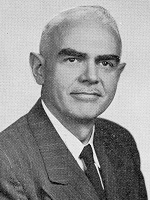 “Michigan’s 85 high school athletic leagues are speculating on the effects of the office of defense transportation plan to whittle sports travel drastically,” stated an Associated Press (AP) article soon after Eastman’s announcement. The Southwestern Conference, comprised of Kalamazoo Central, Benton Harbor, Muskegon, Holland, Grand Haven and Muskegon Heights and one of the most widely spread major prep circuits in the state, was told by its regular bus company that its busses were not available for charter.
“Michigan’s 85 high school athletic leagues are speculating on the effects of the office of defense transportation plan to whittle sports travel drastically,” stated an Associated Press (AP) article soon after Eastman’s announcement. The Southwestern Conference, comprised of Kalamazoo Central, Benton Harbor, Muskegon, Holland, Grand Haven and Muskegon Heights and one of the most widely spread major prep circuits in the state, was told by its regular bus company that its busses were not available for charter.
On Sept. 25, according to AP, “the state department of public instruction warned today that a threat of ‘no new tires’ will be held over rural schools which use their school busses to transport football players to and from games.”
Julian W. Smith, named the interim director of the MHSAA when Charlie Forsythe went into military service, didn’t think the directive would have much impact on football schedules. “However, I believe the order will have a serious effect on basketball schedules this winter and on next year’s football schedule.”
“Four Gallons a Week for Most Drivers”
Two days later it was announced that nationwide gas rationing would go into effect at the beginning of December 1942. More immediately, compulsory tire inspections every 60 days and a “Victory Speed Limit” of 35 miles per hour, effective Oct. 1, were also enacted. “This is not a gasoline rationing program, but a rubber conservation program,” said William M. Jeffers, president of the Union Pacific Railroad, which had been placed in charge of the government’s struggle to alleviate the rubber shortage.
“The object is not to take cars off the road, but to keep them on the road. … The safe life of a tire at 50 miles per hour is only half as great as it is at 30 m.p.h.”
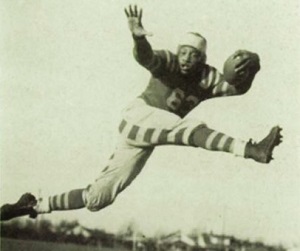 After initial announcements of game cancellations, the impact on high school football in Michigan in 1942 appears to have been minimal. Solutions were found to most challenges. In Bessemer, the high school superintendent announced that “enough persons have volunteered their automobiles to take the Speed Boy players to Calumet” for the game, scheduled for Saturday, Oct. 3. At season’s end, Flint Northern, Detroit Catholic Central, Muskegon, and Wyandotte each lay claim to a share of Michigan’s mythical football title.
After initial announcements of game cancellations, the impact on high school football in Michigan in 1942 appears to have been minimal. Solutions were found to most challenges. In Bessemer, the high school superintendent announced that “enough persons have volunteered their automobiles to take the Speed Boy players to Calumet” for the game, scheduled for Saturday, Oct. 3. At season’s end, Flint Northern, Detroit Catholic Central, Muskegon, and Wyandotte each lay claim to a share of Michigan’s mythical football title.
But a hint of what was to follow came with an announcement concerning the annual Cross Country Finals. The state meet was cancelled to reduce travel, with honors instead awarded during October meets to which schools were assigned based on geography.
In its October 1942 bulletin, the MHSAA endorsed a commando-type “training plan drafted by the Minnesota branch of the office of civilian defense” to “step up scholastic physical fitness programs.” When plotted on a football field, the course bordered the playing area with 11 obstacles spaced 20 yards apart. The course required participants to jump a 4-foot fence, crawl under a 2-foot-high rope, then run between a maze of stakes and, later in the course, high-step through a series of open boxes. Students would scale a 7½-foot wall, walk on a 12-foot balance beam, swing across a broad jump pit from a rope that hung from above, then climb another rope hung from the crossbar of the goal posts. Once accomplished, the participant was to move, hand-over-hand, across the span of the crossbar before dropping to the ground.
At the end of October, the MHSAA’s Representative Council acknowledged the direct contribution that interscholastic sports had on the “lives of students and citizens of the communities in which they are offered” while recommending that they be “retained insofar as possible.”
The committee, however, also emphasized its belief “that physical fitness programs for all students, and intramural sports to offer opportunity for competition to all, should be stressed in the schools’ athletics program.
“In all probability,” it continued, “it will be necessary to modify the general plans of conducting tournaments.” The mechanics of modification would be hammered out at the next Council meeting to be held in December in Lansing.
Financial concerns also were expressed, as much of the Association’s operating budget came from a share of gate receipts of tournaments.
The Impact
“All over the state, athletic directors and coaches are tackling transportation problems. Instead of piling the athletes into privately owned automobiles or school busses, coaches have diligently studied timetables of regular train and bus lines with many satisfactory results,” stated the AP on Dec. 4.
That same day, the MHSAA announced that the upcoming basketball postseason would be altered due to rationing. The story was picked up by various newspapers across the Midwest.
“The association’s Representative Council last night stressed need for following a ‘principle of minimum travel’ in basketball play this winter and voted to dispense with the annual Lower Peninsula finals,” instead opting for a modified layout. Initial conversation related to a plan calling for sectional meets with the possibility of naming titles in the northern half of the Lower Peninsula, and in both the southern and eastern areas. An appointed basketball committee was also to consider combining enrollment classifications wherever necessary to localize tournament play.
From 1932-1947, inclusive, separate Lower and Upper Peninsula basketball champions were determined. The Upper Peninsula Athletic Committee announced a similar plan at its meeting in January of 1943. The committee expected to present winners of the U.P. events with certificates instead of the customary trophies due to shortage of materials prompted by the war.
According to a survey of its 40 member state associations by the National Federation of State High School Associations, Michigan was one of only four states, including Maine, Montana and Nevada, to eliminate naming basketball state champions come the winter of 1943, “since the distances within those states are too vast or transportation facilities are too limited. The same will prevail in track contests.”
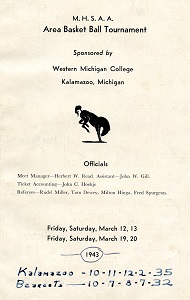 By mid-January, the MHSAA had polled its membership, and approximately 95 percent of the state’s high schools indicated a desire to participate in the replacement tournaments pitched by the Association. After examining the logistics, the plan previously discussed was modified. The Association then identified 51 Lower and 11 Upper Peninsula sites, based on availability to host the tournament and geographic suitability. The competition would run for two weeks, and end with what had previously equaled District championship contests.
By mid-January, the MHSAA had polled its membership, and approximately 95 percent of the state’s high schools indicated a desire to participate in the replacement tournaments pitched by the Association. After examining the logistics, the plan previously discussed was modified. The Association then identified 51 Lower and 11 Upper Peninsula sites, based on availability to host the tournament and geographic suitability. The competition would run for two weeks, and end with what had previously equaled District championship contests.
In the meantime, the annual swim championships were reduced to a one-day meet. Hosted at the University of Michigan, the meet would tax the endurance of individual swimmers, “since officials … decided to conduct semi-final events additional to the customary qualifying trials and finals.” That meant a swimmer entered in two events could compete six times during the day, with qualifying events in the morning, semifinals in the afternoon and finals swum at night. Perennial powers Battle Creek Central and Ann Arbor University High emerged as champions.
“The war to date has proved one thing conclusively – athletics in all schools must go on, for they serve to properly condition our young men for the bigger task ahead,” said MHSAA interim director Smith, speaking at an “annual football and basketball ‘bust’ for Lakeview High School” in Battle Creek in February 1943. Smith had served as principal at the high school for 14 years before taking over at the MHSAA. He “expressed regret” that the MHSAA had altered the various formats of the annual championships. According to coverage of the gathering in the Battle Creek Enquirer, “he intimated that it, along with all other forms of statewide competition, would be restored before another school year begins.”
Continued Chaos
The cities of Lansing and Kalamazoo played host to the most contingents, with 25 teams across the four enrollment classifications playing games at recently completed Lansing Sexton – the rechristened Lansing Central High School – and the Lansing Boys Vocational School. A total of 23 schools squared off at Western Michigan College of Education (now Western Michigan University).
As previously stated, transportation considerations meant some schools played above or below their normal classification to make things work. Ecorse, normally a Class B school, battled in the Class A tournament hosted at Dearborn Fordson. Benton Harbor, with Class A enrollment numbers, competed in the Class B tournament played across the St. Joseph River at St. Joseph High School instead of at the Kalamazoo Area tournament against similarly-sized schools.
A total of 128 area titles were awarded across the state’s two peninsulas. Decatur, the Class C state champion in 1942 with a 25-0 record, was the only team titlist to repeat in 1943, emerging with one of the “Area” crowns and extending its streak of victories to 41 consecutive. Also among the winners was Grand Rapids Union, a “cellar team in the regular season.”
“Although Union stood seventh in the city tally, the Red Hawks won the Area Tournament Crown in three smashing, spine-tingling battles,” stated the sports editor in the 1943 Aurora - Union’s yearbook. “In fast games the Hawks overcame Catholic and beat the Creston Bears … as well as whipping Davis Tech for their final victory.”
In April, the MHSAA confirmed that competition would end with area, city or conference meets in track, and again in tennis and golf, because of transportation, participation issues, and the “prospects of closing of some of the schools early.”
Various fans and media members grumbled about the unsatisfying conclusion to the prep sports calendars.
Hope
The coaching ranks were heavily hit by the war, as numerous mentors were tapped by the armed forces to lead physical fitness programs. Despite initial concerns, few “of the state’s 400 football-playing prep schools” dropped the sport come the 1943-44 school year. As it would turn out, because of the travel constraints, attendance increased as more and more sports fans turned to high school competition for entertainment.
Smith stated in October that he had “yet to find anyone who is definitely against bringing the (basketball) championship tournament back to life. There seems to be overwhelming sentiment in favor of the revival. The schools right-about face on the state cage classic which annually drew 700 prep teams and 11,000 players is explained by the fact coaches now feel the federal government is strongly in favor of any attempt to encourage or extend athletics. Last year schoolmen were not certain what the government’s attitude on sports would be and were hesitant about continuing athletics in pre-war style.”
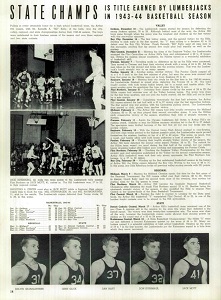 Only 258 of 614 schools replied to a questionnaire about restoring the winter basketball state championships, but 73 percent of respondents were in favor of such, and in December, the Representative Council voted to resume the final rounds of the tournaments.
Only 258 of 614 schools replied to a questionnaire about restoring the winter basketball state championships, but 73 percent of respondents were in favor of such, and in December, the Representative Council voted to resume the final rounds of the tournaments.
Born October 1918 in St. Johns, Michigan at the peak of the “Spanish Flu” pandemic, Hal Schram was a 25-year-old sports reporter for the Lansing State Journal when he covered the restart.
“State championship basketball and track competition once more became a part of (the) Michigan high school athletic program when the Representative Council of the MHSAA voted to reinstate these two state-wide tournaments after a suspension of one year,” he wrote.
According to Schram, “It was believed that student working hours, transportation, scarcity of balls and general lack of interest” still necessitated cancellation of golf and tennis tournaments for the year. Conduction of a swimming championship was left “in the hands of a committee representing schools which sponsor the sport … subject to the approval of the representative committee.”
Plans were to return the final rounds of the basketball tournament to Jenison Field House on the campus of Michigan State, which had hosted those rounds from 1940-42. However, the facility was in use by Army trainees for a physical fitness program.
“We would like to have the finals staged here very much,” said MSC athletic director Ralph Young, “but our obligations to the army come first.”
“Despite the hitch, the executive committee opted to stay in Lansing, playing Class A and C semifinal contests at the Boys Vocational School fieldhouse, and Class B and D semi games at Sexton High School. Finals were held at the Vocational gym.
“Fifty-five hundred spectators jammed their way into every nook and cranny of the Boys Vocational school fieldhouse last night to see four high school teams (Saginaw Arthur Hill, Marshall, Lansing St. Mary, Benton Harbor St. John) win championships in the Lower Peninsula tournament finals. With all seats taken almost before the first game started, the big floor was completely encircled by people sitting and standing before the finish,” wrote State Journal sports editor George S. Alderton. “By 6 o’clock, when the Class D game started, all seats in the side bleachers had been filled and most of the end bleachers were gone. The last vacancy was occupied before the Class C game started at 7:15 o’clock and from that time on, those who came either stood or seized a seat left by some departing fan. In many instances two sat down when one departed. Corners of the court were seething masses of humanity …”
United Press International wire reports indicated that 8,500 in total saw the Finals, as fans shifted in and out of the venue in support of the participating teams. “Some people had to be turned away at the finals,” said Smith, “and that certainly shows that people need and want this kind of relaxation.” The previous three Finals at MSC had drawn between 6,000-7,000 fans, while the 1939 Finals at I.M.A in Flint drew 5,000 and the 1938 event at Grand Rapids Civic Auditorium saw 6,000 attend.
“Lighting was so poor in the press box Friday night for the semi-finals,” added Alderton, “that workers came equipped with candles for the finals on Saturday night and propped them against their typewriters.”
Ishpeming hosted the Upper Peninsula Finals, as Escanaba, Crystal Falls, Channing and Amasa swept titles, respectively, in Classes B, C, D and Class E – the state’s smallest classification, reserved only for the smallest U.P. schools based on enrollment.
“Only complaint,” noted the Marquette Mining Journal, “was from those who couldn’t get in or were caught in a jam of fans seeking general admission seats. … Probably another 100 to 200 could have been accommodated if they were permitted to sit on the floor all along the court lines, but this would have been hazardous to players and fans …”
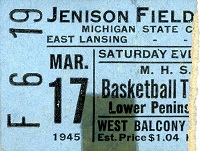 (The Lower Peninsula finals returned to Jenison in 1945 – where they stayed, uninterrupted, through 1970 – and were played before 7,833 spectators that first season back. Locals were delighted as they watched Lansing Sexton top Benton Harbor’s undefeated Tigers, 31-30. Michigan Governor Harry Kelly “personally presented the Class B championship trophy to Sturgis Capt. Tom Tobar, congratulated Capt. Larry Thomson of East Lansing and then shook hands with the captains of the Class A contest before the game started.”)
(The Lower Peninsula finals returned to Jenison in 1945 – where they stayed, uninterrupted, through 1970 – and were played before 7,833 spectators that first season back. Locals were delighted as they watched Lansing Sexton top Benton Harbor’s undefeated Tigers, 31-30. Michigan Governor Harry Kelly “personally presented the Class B championship trophy to Sturgis Capt. Tom Tobar, congratulated Capt. Larry Thomson of East Lansing and then shook hands with the captains of the Class A contest before the game started.”)
In mid-May, “some 800 Michigan prep trackmen, survivors of 40 regionals at 10 centers” headed to Michigan State College to determine statewide champs. Only Kalamazoo in Class A and Birmingham in Class B held the chance to “repeat” as team champions. Instead, Saginaw Arthur Hill capped a stellar sports year, earning its first Class A team track title to go with its recently-earned basketball crown. (Earlier in the school year, the Lumberjacks also had opened their own football field.)
East Grand Rapids earned its second track title, grabbing the Class B crown. Fowlerville and Glen Arbor Leelanau brought home titles in Class C and D, respectively.
All sports – including golf and tennis which had gone three years without competing in a true state title round – returned to their original formats with the start of the 1944-45 school year.
In May 1945, Germany surrendered to the Allies, followed by Imperial Japan’s surrender, announced in August.
Participation in prep sports and attendance numbers would explode across the state and the nation in the coming years, tied to multiple factors, including, of course, the baby boom that followed World War II.
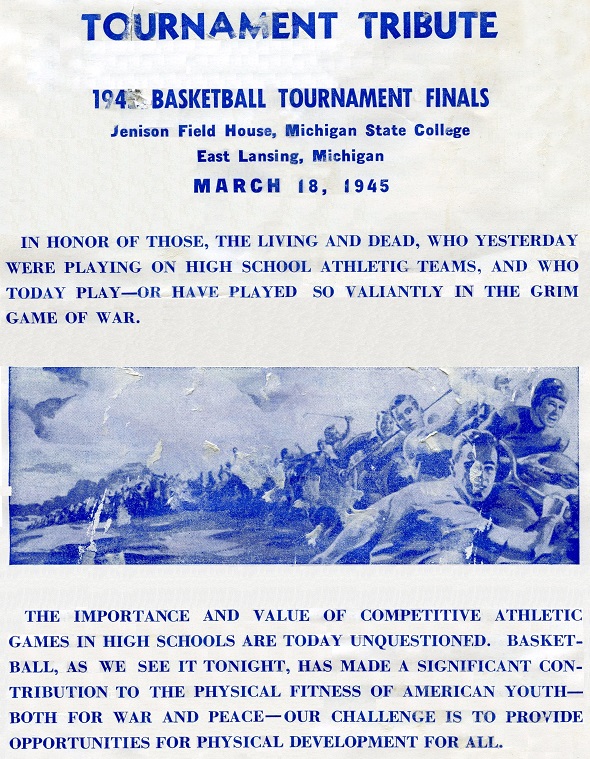
 Ron Pesch has taken an active role in researching the history of MHSAA events since 1985 and began writing for MHSAA Finals programs in 1986, adding additional features and "flashbacks" in 1992. He inherited the title of MHSAA historian from the late Dick Kishpaugh following the 1993-94 school year, and resides in Muskegon. Contact him at [email protected] with ideas for historical articles.
Ron Pesch has taken an active role in researching the history of MHSAA events since 1985 and began writing for MHSAA Finals programs in 1986, adding additional features and "flashbacks" in 1992. He inherited the title of MHSAA historian from the late Dick Kishpaugh following the 1993-94 school year, and resides in Muskegon. Contact him at [email protected] with ideas for historical articles.
PHOTOS: (Top) Grand Rapids Union was among "Area" boys basketball champions in 1943. (2) Lewis Forsythe, left, and Charles Forsythe were among leaders during the MHSAA's first decades (3) The Saginaw Arthur Hill yearbook for 1944 tells of fitness training undertaken by students. (4) Julian W. Smith served as interim MHSAA executive director while Charles Forsythe was serving in the military. (5) Flint Northern's Bill Hamilton earned all-state honors in 1942. (6) Western Michigan College was among hosts of 1943 Area tournaments. (7) Arthur Hill's yearbook celebrates the 1943-44 boys basketball championship. (8) Basketball Finals returned to Jenison Field House in 1945. (9) The MHSAA paid tribute to World War II veterans in its 1945 Basketball Finals program.

